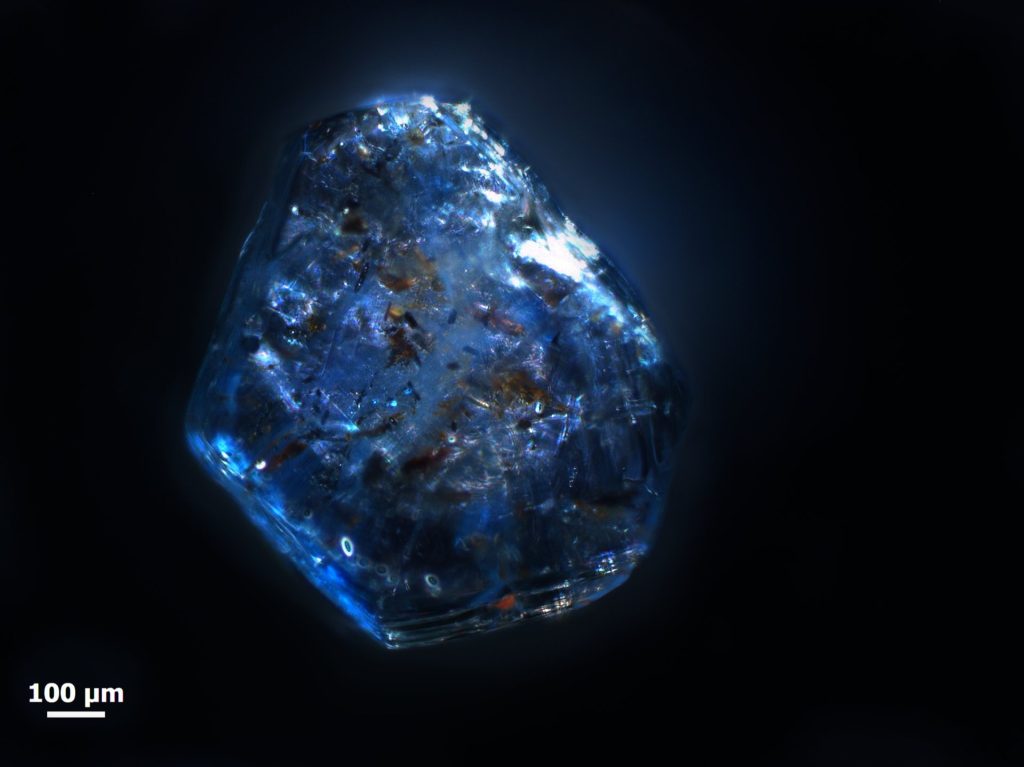Photo credit: Sapphire from the sediments of the River Kill in the western Eifel. The crystals are about 0.9 mm in diameter. Photo credit: Sebastian Schmidt
Researchers from the University of Heidelberg are studying the formation of these characteristic blue crystals in volcanic melt.
Sapphire is one of the most precious gemstones, yet it is composed entirely of chemically “tainted” aluminum oxide, or corundum. Around the world, these distinctive blue-colored crystals are found primarily in association with silicon-poor volcanic rocks. This association is widely believed to be because sapphire originated from rocks deep within the Earth’s crust and accidentally found its way to the Earth’s surface as magma rose.
Geologists from the University of Heidelberg have used geochemical analysis to identify millimeter-sized sapphire The particles found in the Eifel (Germany) were formed in connection with volcanic activity. Published In the journal Contributions to mineralogy and petrology.
The Eifel Volcanic areas In central Europe, magma from the Earth’s mantle has been percolating into the upper crust for about 700,000 years. The melt is poor in silicon dioxide but rich in sodium and potassium. Magmas of similar composition around the world are known to be rich in sapphires. Why this highly unusual corundum variety is so often found in these types of volcanic deposits has been a mystery until now.
“One explanation is that sapphire in the crust formed under high pressure and heat from previously clayey sediments, with rising magma acting as an elevator to bring the crystals to the surface,” explains Professor Axel Schmidt, a researcher at Curtin University in Perth, Australia, and emeritus professor of isotope geology and petrology at his former affiliation, the University of Heidelberg’s Institute of Geosciences.
To test this hypothesis, the researchers examined 223 sapphires from the Eifel region. They found that some of these millimeter-sized crystals rock Samples taken from volcanic deposits in the region’s numerous quarries, although most sapphires come from river deposits.
“Like gold, sapphire is extremely weather-resistant compared to other minerals. Over time, the particles are washed out of the rocks and deposited in rivers. Due to its density, it can be easily separated from the lighter sediment components using a gold dish,” explains Sebastian Schmidt, who carried out the research as part of his master’s degree at the University of Heidelberg.
The researchers dated the Eifel sapphires using the uranium-lead method on mineral inclusions within the sapphires, using a secondary ion mass spectrometer that can also determine oxygen isotope composition. Differences in the relative abundance of the light isotope O-16 and the heavy isotope O-18 provide information about the crystals’ origins, like a fingerprint. Rocks deep in the Earth’s crust contain more O-18 than those dissolved from the Earth’s mantle.
As dating shows, the Eifel sapphires formed simultaneously with volcanic activity. They partly inherited the isotopic signature of mantle melt that heated and partially melted and contaminated crustal rocks at a depth of about 5-7 kilometers. Other sapphires were produced by contact with underground melt, which permeated adjacent rocks and caused the formation of sapphire.
“In the Eifel, both magmatic and metamorphic processes, in which temperature changes the parent rock, influenced sapphire crystallization,” Schmidt said.
For more information:
Sebastian Schmidt et al., Petrologically controlled oxygen isotope classification of syngeneic magmatic and metamorphic sapphires from the Quaternary volcanic field of the Eifel, Germany. Contributions to mineralogy and petrology (2024). DOI: 10.1007/s00410-024-02136-x
Provided by
University of Heidelberg
Quote: The Eifel’s Blue Miracle: How Sapphires Form in Volcanoes (July 29, 2024) Retrieved July 30, 2024 from https://phys.org/news/2024-07-blue-miracle-eifel-sapphires-volcanoes.html
This document is subject to copyright. It may not be reproduced without written permission, except for fair dealing for the purposes of personal study or research. The content is provided for informational purposes only.


